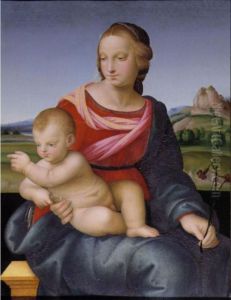Cesare Domenico Di Alfani Di Paride Paintings
Cesare Domenico di Alfani, also known simply as Domenico Alfani, was an Italian painter active during the High Renaissance, born in 1497 in Perugia, Italy. He was a contemporary and collaborator with Raphael, one of the most celebrated artists of the period. Although not as widely recognized as Raphael, Alfani contributed significantly to the art scene of his time, particularly within his native city of Perugia.
Domenico Alfani’s career was significantly influenced by his close association with Raphael, whom he met through his father, Orazio Alfani, also an artist. This connection allowed him to immerse himself in the innovative artistic environment of the time. Alfani's style was deeply influenced by Raphael’s work, evident in his adoption of the High Renaissance ideals of balance, harmony, and the pursuit of beauty. Despite this influence, Alfani developed his unique style, characterized by a more restrained use of color and a focus on religious themes.
Throughout his career, Alfani worked on various commissions, mainly religious works for churches in Perugia. His paintings are known for their devout expressions and delicate treatment of figures, reflecting the religious fervor of the period. One of his most notable works is the altarpiece in the church of San Pietro in Perugia, showcasing his mastery in composition and his ability to convey spiritual narratives.
Alfani’s contribution to the art world also extended beyond his paintings. He was involved in the artistic community of Perugia, contributing to the development of local art practices and mentoring younger artists. His legacy is also tied to his son, Orazio Alfani, who followed in his footsteps and became a prominent painter in Perugia.
Cesare Domenico di Alfani died in 1553 in Perugia. Although his work was somewhat overshadowed by the giants of the Renaissance, his contributions to the Perugian school of painting and his influence on the local art scene of his time have been recognized by art historians. Today, Alfani’s works are preserved in various museums and collections, testament to his skill and dedication to the ideals of the Renaissance.
